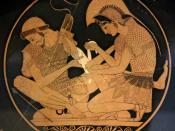One of the most controversial questions of all time: Did the famous Trojan War actually occur? Homer's legend of Princes falling in love with unavailable Queens, Gods fighting over the title of the fairest of them all and ruthless demi-gods capable of changing the fate of a war in his story the 'Iliad', are all nice stories yet they can't actually be proven. But what evidence do we have that could support these mythical legends? Archaeologists such as Calvert, Schliemann, Dorpfeld, Korfmann and historians such as Thucydides have established some provable ground for the Trojan War.
Written sources suggesting the Trojan War is real are in scarce amounts, the main source is Homers 'Iliad'. Homers 'Iliad' describes Troy as a great city upon a hill across the plain of Scamander where the great battle took place, a city defended by mighty walls and towers with temples for Athena and Apollo.
This information was used by Archaeologists to find the illusive city of Troy. Homers 'Iliad' also describes the great leaders of the Trojan War such as Agamemnon and Priam. Agamemnon the leader of the Mycenaean's in Homers Trojan War is depicted as 'the most powerful ruler of his day'-Thucydides The Peloponnesian War Book 1.9 by Thucydides. Mycenae was famously described as 'rich as gold' by Homer in the 'Iliad'. Schliemann an archaeologist found 15 skeletons each covered in gold and one with a golden funeral mask which he proclaimed was the mask of Agamemnon. Schliemann was wrong in his findings, the death mask was of an earlier period but the likeliness to Agamemnon's death mask is still challenged by modern Archaeologists. The so called treasures of Priam where discovered by Schliemann as well. The 'Iliad' isn't the only source that suggests a war there is also the Mycenaean Linear...


